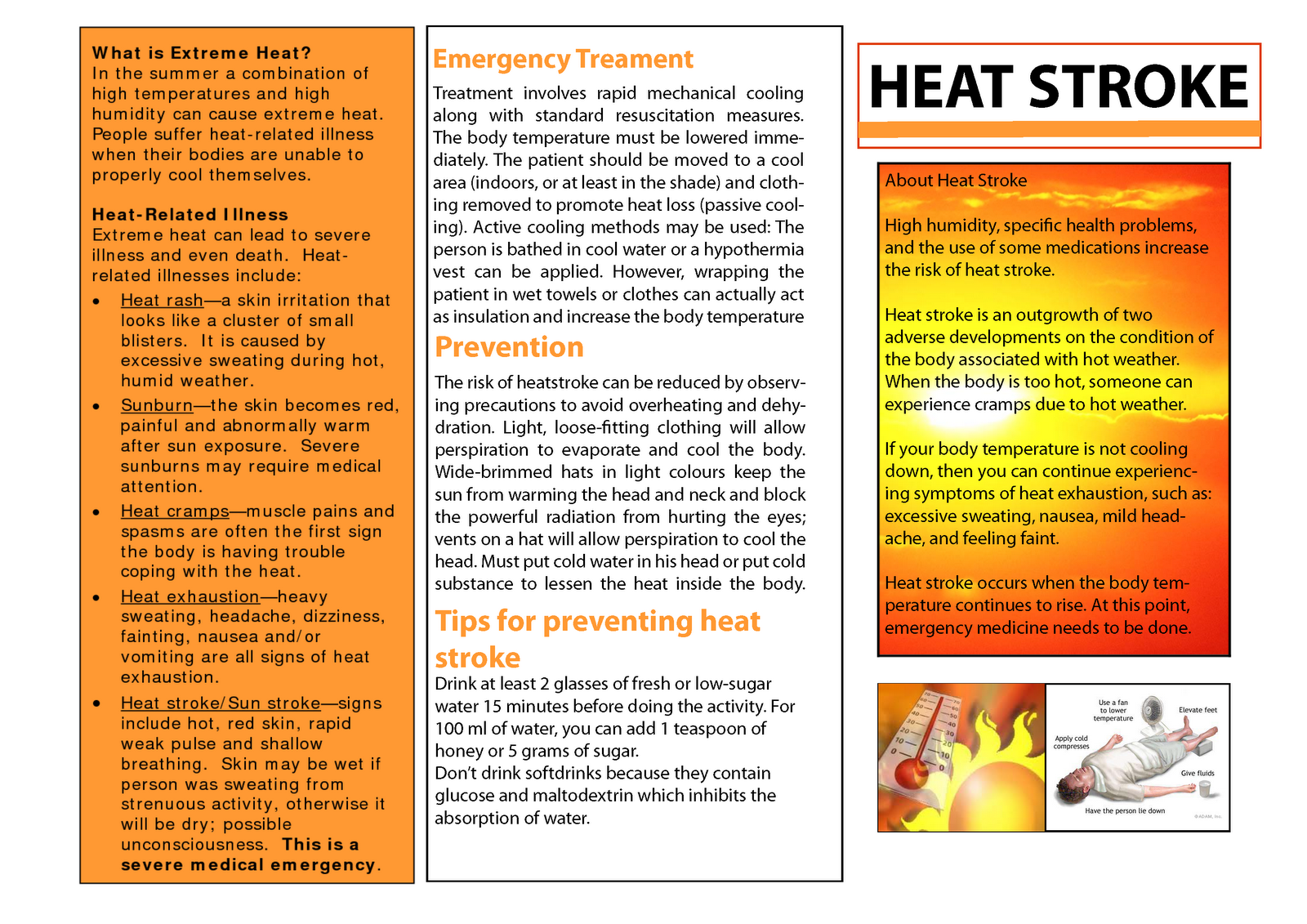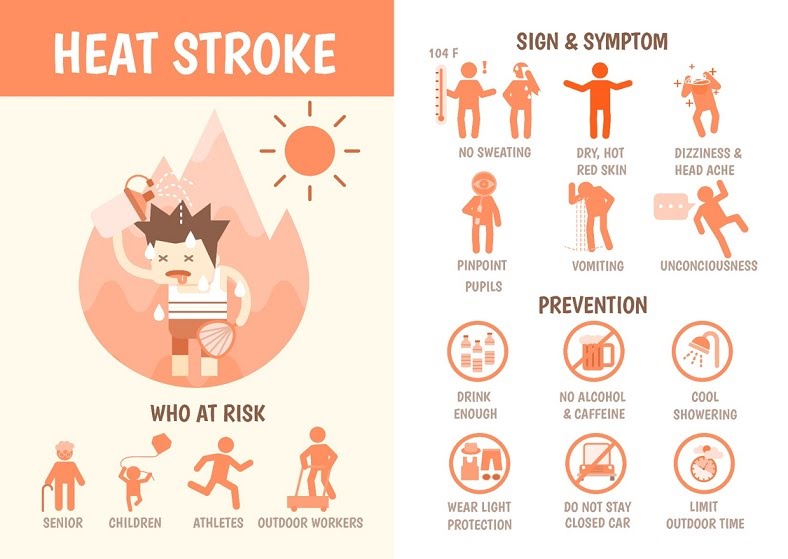Heat stroke, also known as sunstroke, is a severe condition that arises when the body overheats due to prolonged exposure to high temperatures or physical exertion in hot environments. It is a medical emergency that requires immediate attention, as it can lead to serious complications or even death if not treated promptly. HS is often misunderstood, but understanding its causes, recognizing its symptoms, and taking preventive measures can save lives. In this article, we will explore the factors that contribute to heat stroke, the signs to watch out for, and effective strategies to avoid this potentially life-threatening condition.

What is Heat Stroke?
Heat stroke occurs when the body’s core temperature rises to dangerous levels, typically above 104 degrees Fahrenheit. At this point, the body’s natural cooling mechanisms, such as sweating, become overwhelmed and fail to regulate temperature effectively. Unlike milder forms of heat-related illnesses, such as heat exhaustion, heat stroke is a critical condition that demands urgent medical intervention.
There are two primary types of heat stroke:
- Classic Heat Stroke: This type usually affects individuals who are exposed to high temperatures over an extended period, particularly older adults, young children, and those with chronic health conditions.
- Exertional Heat Stroke: This form occurs in people who engage in strenuous physical activity in hot environments, often affecting athletes, laborers, and military personnel.
Causes of Heat Stroke
Several factors can contribute to the development of heat stroke. These include environmental conditions, individual risk factors, and specific activities that increase the likelihood of overheating.
Environmental Factors
The most obvious cause of heat stroke is exposure to extreme heat. When temperatures soar, especially in combination with high humidity, the body struggles to cool itself through sweating. High humidity prevents sweat from evaporating efficiently, which reduces the body’s ability to release heat. Urban areas, where concrete and asphalt absorb and retain heat, can exacerbate the problem, creating what is known as the “urban heat island effect.”
Individual Risk Factors
Certain groups of people are more vulnerable to heat stroke due to physiological or health-related reasons:
- Age: Infants and young children, as well as older adults, are at higher risk because their bodies are less efficient at regulating temperature.
- Chronic Illnesses: Conditions such as heart disease, obesity, and diabetes can impair the body’s ability to cool itself.
- Medications: Some medications, including diuretics, antihistamines, and beta-blockers, can interfere with the body’s thermoregulation processes.
- Dehydration: A lack of adequate fluid intake reduces the body’s ability to produce sweat, making it harder to cool down.
Physical Activity in Hot Environments
Engaging in intense physical activity in hot and humid conditions significantly increases the risk of heat stroke. Athletes participating in outdoor sports, construction workers, and military personnel are particularly susceptible. Wearing heavy or tight clothing that traps heat can further elevate the risk.
Symptoms of Heat Stroke
Recognizing the symptoms of heat stroke is crucial for timely intervention. The signs can vary depending on the severity of the condition, but they generally include the following:
Physical Symptoms
- High Body Temperature: A core body temperature of 104 degrees Fahrenheit or higher is a hallmark sign of heat stroke.
- Altered Mental State: Confusion, agitation, slurred speech, seizures, or even loss of consciousness may occur.
- Skin Changes: The skin may feel hot and dry to the touch, although in some cases, it may still be sweaty.
- Rapid Breathing and Heart Rate: Breathing may become shallow and rapid, and the pulse may accelerate as the body attempts to cool itself.
- Nausea and Vomiting: Some individuals may experience gastrointestinal distress.
- Headache: A throbbing headache is a common symptom of heat stroke.
Distinguishing Heat Stroke from Other Heat-Related Illnesses
It is important to differentiate heat stroke from milder heat-related conditions, such as heat exhaustion. While both involve overheating, heat exhaustion does not result in a dangerously high body temperature or altered mental state. If left untreated, however, heat exhaustion can progress to heat stroke.
Prevention of Heat Stroke
Preventing heat stroke involves a combination of lifestyle adjustments, awareness of environmental conditions, and proactive measures to stay cool and hydrated. Below are some practical strategies to reduce the risk of heat stroke:
Stay Hydrated
Proper hydration is one of the most effective ways to prevent heat stroke. Drinking plenty of water throughout the day helps maintain the body’s ability to regulate temperature. Avoid beverages that can lead to dehydration, such as alcohol and caffeine, especially in hot weather. For individuals engaging in physical activity, electrolyte-rich drinks can help replenish lost minerals.
Limit Exposure to Extreme Heat
When temperatures are high, it is advisable to stay indoors during the hottest parts of the day, typically between late morning and early afternoon. If you must go outside, seek shade and wear lightweight, loose-fitting clothing that allows sweat to evaporate. Hats and sunglasses can provide additional protection from direct sunlight.
Use Cooling Measures
Taking steps to cool the body can help prevent overheating. These measures include:
- Taking Cool Showers: A cool shower or bath can lower body temperature quickly.
- Using Fans or Air Conditioning: Fans can help circulate air, while air conditioning provides a controlled environment to escape the heat.
- Applying Cold Compresses: Placing a cold, damp cloth on the neck, wrists, or other pulse points can aid in cooling.
Be Mindful During Physical Activity
If you plan to exercise or work outdoors in hot conditions, take precautions to avoid heat stroke:
- Acclimate Gradually: Allow your body time to adjust to the heat by gradually increasing the intensity and duration of activity.
- Take Frequent Breaks: Rest in shaded or air-conditioned areas to give your body a chance to cool down.
- Monitor Yourself and Others: Pay attention to how you and those around you are feeling. Early signs of heat-related illness should not be ignored.
Educate and Prepare
Understanding the risks and knowing how to respond can make a significant difference. Educate family members, coworkers, and community members about the dangers of heat stroke and the importance of prevention. Keep a first aid kit handy and know the location of the nearest medical facility in case of an emergency.
Special Considerations for Vulnerable Populations
Certain groups require extra attention and care to prevent heat stroke. These include:
Older Adults
As people age, their bodies become less efficient at regulating temperature. Older adults should be encouraged to stay hydrated, use air conditioning, and avoid unnecessary exposure to heat. Caregivers should regularly check on elderly individuals during heat waves.
Children
Young children are highly susceptible to heat-related illnesses. Never leave children unattended in vehicles, even for a short period, as temperatures inside cars can rise rapidly. Ensure that children drink enough fluids and wear appropriate clothing during outdoor activities.
Individuals with Chronic Health Conditions
People with conditions such as heart disease, diabetes, or respiratory disorders should consult their healthcare providers for personalized advice on managing heat exposure. They should also monitor their symptoms closely and seek medical attention if necessary.
Responding to Heat Stroke
In the event of a suspected heat stroke, prompt action is essential. While waiting for emergency medical services to arrive, follow these steps:
- Move the Person to a Cooler Area: Take them indoors or to a shaded location.
- Remove Excess Clothing: Loosen or remove tight clothing to facilitate cooling.
- Cool the Body: Use cool water, fans, or ice packs to lower the person’s temperature.
- Do Not Give Fluids: Avoid giving anything to drink if the person is unconscious or vomiting.
Heat stroke is a serious condition that demands vigilance and proactive measures. By understanding its causes, recognizing its symptoms, and implementing preventive strategies, we can protect ourselves and others from its potentially devastating effects.





